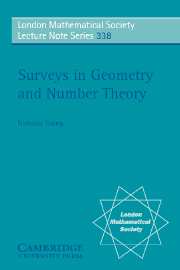Book contents
- Frontmatter
- Contents
- Preface
- Affine embeddings of homogeneous spaces
- Formal groups over local fields: a constructive approach
- Classification problems and mirror duality
- Birational models of del Pezzo fibrations
- Best Diophantine approximations
- Projectively dual varieties of homogeneous spaces
- Equivariant embeddings of homogeneous spaces
- Geometric quantization and algebraic Lagrangian geometry
Preface
Published online by Cambridge University Press: 07 May 2010
- Frontmatter
- Contents
- Preface
- Affine embeddings of homogeneous spaces
- Formal groups over local fields: a constructive approach
- Classification problems and mirror duality
- Birational models of del Pezzo fibrations
- Best Diophantine approximations
- Projectively dual varieties of homogeneous spaces
- Equivariant embeddings of homogeneous spaces
- Geometric quantization and algebraic Lagrangian geometry
Summary
This volume is a showcase for the continuing vitality of Russian mathematics in fields related to algebraic geometry. The Eastern European scientific diaspora may have weakened the magnificent edifice of Russian mathematics, but the Russian school had both strength and depth, and there remains a great deal of important scientific activity in the country. Universities continue to attract some of the most able students into mathematics, and their graduates have the knowledge and enthusiasm to be effective participants in the global mathematical endeavour.
There are great difficulties facing new Russian ‘Candidates of Science’ in mathematics. It is rare for a young person to gain a living wage as a lecturer and researcher alone. It requires dedication, self-sacrifice and a willingness to look for other sources of income for a mathematician to become established while remaining in Russia. It is not surprising that many talented mathematicians seek and find employment abroad. Despite these handicaps there are strong research groups that continue to foster new talents.
In the fields of algebraic geometry and algebraic number theory there are healthy groups, particularly those centred around the Steklov Institute in Moscow. To give some examples, in the birational geometry of 3-folds there is a group of four well-established experts who support about 10 research students and postdoctoral fellows. Another group of specialists pioneered the idea of the derived category of coherent sheaves on a variety (up to equivalence) as a geometric invariant of the variety, analogous to K-theory or cohomology theories, and continues to work in this fruitful area.
- Type
- Chapter
- Information
- Surveys in Geometry and Number TheoryReports on Contemporary Russian Mathematics, pp. vii - viiiPublisher: Cambridge University PressPrint publication year: 2007

